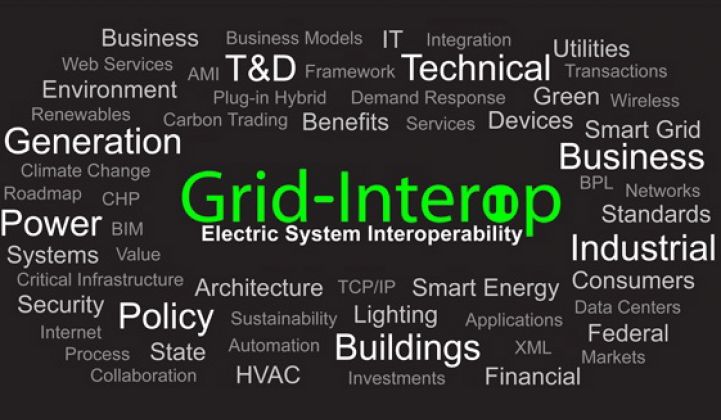Grid-Interop 2011 kicked off in Phoenix this week with this exhortation from Vint Cerf, founding father of the internet: "Nothing is as convincing as something that works."
In pursuit of that principle, we’re going to see just about every smart grid company there is at this week's big smart grid interoperability fest, showing off how its technology can work with everybody else’s -- even if the technologies in question aren’t quite commercially available yet.
That’s the case with Tendril’s big demo, at least. The Boulder, Colo.-based home energy management startup is showing off a dream combo of sorts, connecting a MMB Research Wi-Fi thermostat and Tendril’s smart plug and load control devices and controlling them via smart meter ZigBee communications, as well as Tendril’s next-generation broadband gateway platform.
The test uses both ZigBee Smart Energy Profile 1.x (the technology being rolled out for smart meter-to-home networking in Texas, Australia and other regions) and a pre-release version of Smart Energy 2.0, the protocol that will allow ZigBee, Wi-Fi and HomePlug technologies to communicate using the same language, so to speak. Many in the smart grid industry are worried that today’s SEP 1.x systems will have trouble upgrading to SE 2.0 when it rolls out over the next couple of years, so demonstrating that the two systems can work together is a big deal.
Not only that, but Tendril is also taking OpenADR signals -- a standard for utilities and vendors to communicate demand response events -- and delivering them via its next-generation gateway to its in-home devices, Tendril CTO Kent Dickson told me.
The OpenADR signals are coming from Honeywell and Lockheed Martin devices, but Tendril is also working with other vendors that are developing OpenADR systems, he said. While Tendril’s next-generation gateway that’s translating them for in-home devices is still in development, it demonstrates that smart meters aren’t the only way to connect home devices to utilities.
Tying it all together is the Tendril Connect cloud platform, which Tendril opened to third-party developers in August. While just about every smart grid player is working on a cloud computing platform of some kind, Tendril is supporting multiple third-party devices in pilot projects, running applications built by Tendril and others, Dickson said.
In the crowded and still-nascent home energy management market, linking to as many partners and technologies as possible will be very important. Right now, Tendril is working on connecting smart appliances from Whirlpool, geothermal water heaters from WaterFurnace and home control systems from Vivint, to name a few.
While Tendril and others demonstrate interoperability using still-developing technologies, another emerging technology for linking devices via the same wires that power them saw its first commercial launch on Tuesday.
That’s Qualcomm Atheros’s QCA7000 chip, the first commercially available “silicon solution” for the HomePlugGreen PHY standard. While ZigBee and Wi-Fi are jockeying for position in wirelessly connecting energy-smart home devices, HomePlug has emerged as a chief standard for powerline carrier (PLC) networking, which carries data over electric wires.
HomePlug’s higher-bandwidth AV system is already in some 45 million devices, mostly delivering IPTV to households in Europe. But while HomePlug AV is being tested by Michigan utility Consumers Energy in General Electric smart meters, it’s generally considered too power-hungry for most in-home applications.
Enter HomePlug Green PHY, a lower-power, lower-bandwidth technology that’s been under development for the past few years. Atheros won a $4.5 million Department of Energy grant last year to develop chipsets for Green PHY, and Qualcomm bought Atheros in January. That’s about 18 months from specification release to commercial product launch, giving a sense of the time it takes to get new standards to market.
Jim Zyren, smart grid products marketing director at Qualcomm Atheros, told me Tuesday that the company is shipping the chips to “lead customers” that intend to integrate them into products, though he wouldn’t name the customers.
While the majority of smart meters being deployed today are using wireless technologies (mainly ZigBee) to connect to in-home devices, certain applications really lend themselves to a powerline solution, Zyren noted. Those include apartment buildings where power meters are in the basement, making it difficult for wireless signals to reach apartments on the floors above.
As for interoperability tests, Qualcomm Atheros has a demo at Grid-Interop showing how Smart Energy 2.0 packets can be passed across Wi-Fi, Ethernet, HomePlug AV and HomePlug GreenPHY channels to deliver energy-saving messages -- even though, once again, SE 2.0 is still expected to be at least a year away from being ready for market.
Beyond energy-smart homes, Green PHY has also gotten a big endorsement from German and U.S. automakers that are supporting the standard for electric vehicle charging communications, Zyren noted. Of course, plug-in car charging communications are still a wide-open field, and we’re sure to see alternative communications methods vying for space in that business, as well.



